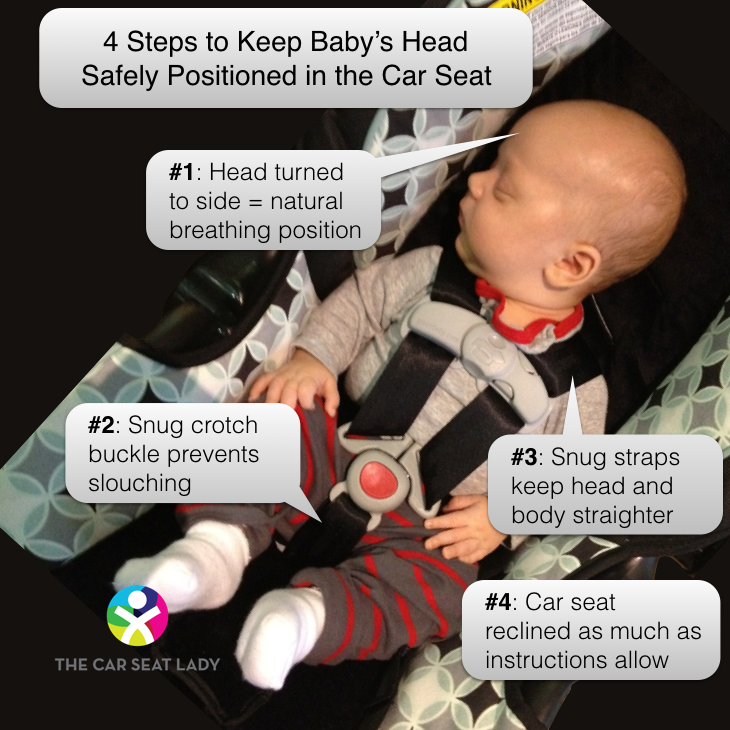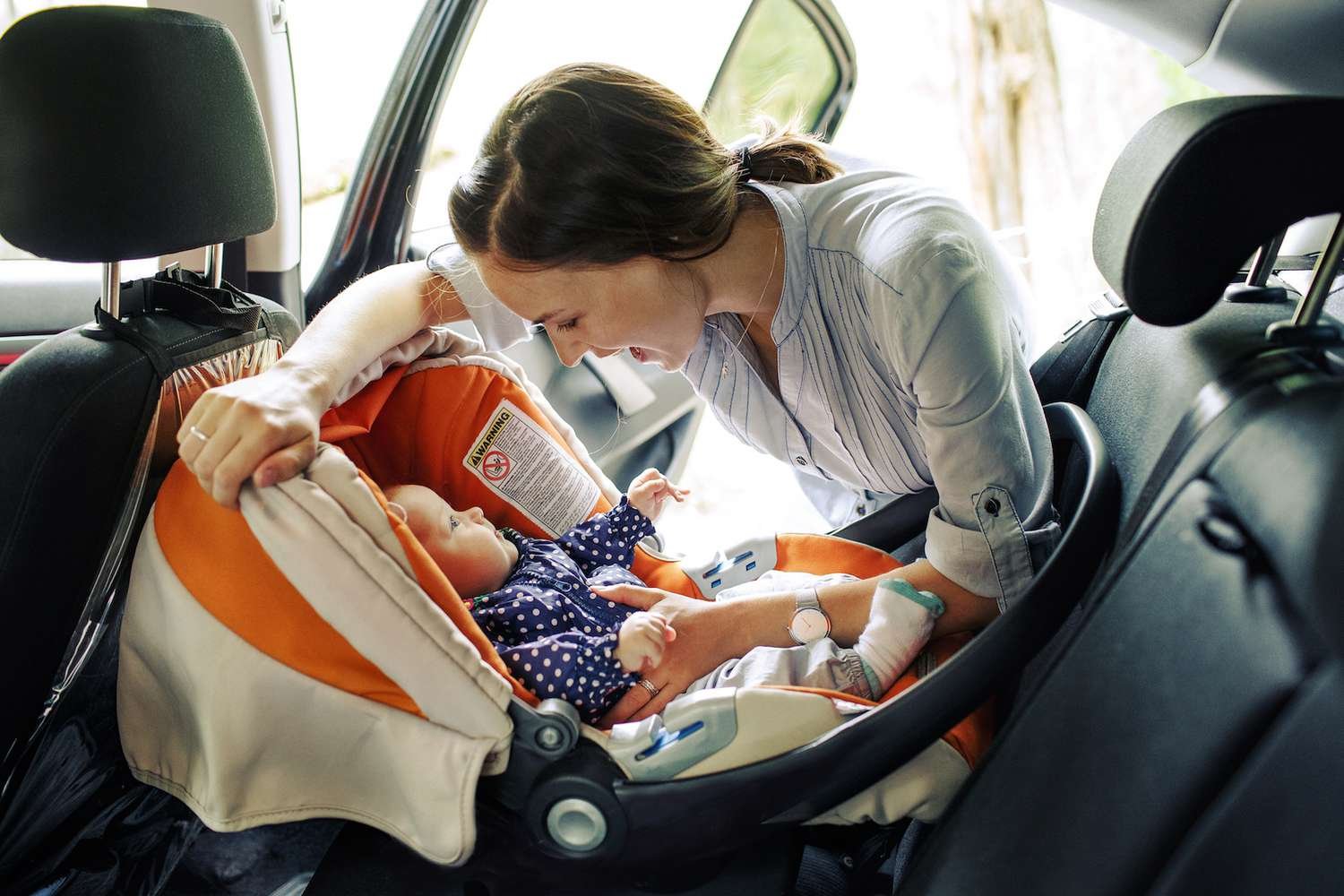Placing a newborn in a car seat correctly ensures safety. Follow a few simple steps to secure your baby for travel.
Car seats can be tricky, especially for new parents. Understanding how to position your newborn safely is crucial. This guide helps you navigate the process with ease. It covers everything from choosing the right seat to securing straps. You’ll learn tips to ensure comfort and safety.
Proper installation prevents injuries and keeps your baby secure. With clear instructions, you’ll gain confidence in handling car seats. It’s important to check your baby’s position often. This ensures they are comfortable and safe. Ready to learn more? Let’s dive into the essentials for keeping your newborn safe in the car.

Credit: thecarseatlady.com
Choosing The Right Car Seat
Choosing the right car seat for your newborn is vital. Safety is the top priority, but comfort matters too. A good car seat protects your baby in case of an accident. It also ensures a snug fit for those long drives. Parents often feel overwhelmed by choices. But knowing what to look for simplifies the process.
Types Of Car Seats
There are various types of car seats available. Infant car seats are popular for newborns. They face the rear of the car. Convertible car seats grow with your child. They switch from rear-facing to forward-facing. All-in-one car seats offer flexibility. They serve as booster seats later on. Choose a type based on your needs and budget.
Features To Look For
Consider key features when selecting a car seat. Look for a five-point harness. This provides better security for your baby. Check for easy installation options. A latch system simplifies setup. Padding and head support offer comfort. Ensure the seat cover is washable. Babies can be messy! Adjustable straps are also important. They offer a secure fit as your baby grows.
Installation Basics
Securing your newborn in a car seat involves careful positioning. Ensure the seat is rear-facing and reclined properly. Fasten the harness snugly over your baby’s shoulders for safety.
Installing a newborn car seat might feel like an overwhelming task, but mastering the basics can make this essential step a breeze. Ensuring your newborn’s safety during car rides starts with a properly installed car seat. Let’s break it down into simple, actionable steps.###Location In The Vehicle
Choosing the right location for your newborn’s car seat is crucial. The safest spot is the back seat, ideally in the middle, away from active airbags. If the middle seat doesn’t have the proper seat belt or latch system, the right or left side of the back seat is also acceptable.Why the back seat? It reduces the risk of injury during side-impact collisions. Remember, convenience should never outweigh safety when it comes to your baby.###Securing The Car Seat
Securing the car seat correctly ensures it does its job in protecting your child. Start by checking your vehicle’s manual and the car seat’s instructions. Every car and car seat is different, so this step is vital for a secure fit.Use either the seat belt or the LATCH (Lower Anchors and Tethers for Children) system, not both. Make sure there is no more than one inch of movement from side to side or front to back. A tight fit is key to safety.Have you ever noticed the car seat moving or tilting while driving? That’s a sign it isn’t secured properly. Recheck the installation to prevent any mishaps.Installing a car seat can seem daunting at first, but with these simple steps, you’re on the right path to ensuring your newborn’s safety. What challenges have you faced while installing a car seat? Share your experiences and tips in the comments below!Preparing For The First Ride
Preparing for that special first ride with your newborn involves correctly placing them in a car seat. First, adjust the harness straps to fit snugly over the baby’s shoulders. Ensure the car seat is at the right angle to keep the baby’s head from falling forward.
Double-check the buckle and clips for safety before starting your journey.
Preparing for the First RideThere’s something magical about the moment you bring your newborn home for the first time. The anticipation, the joy, and yes, a bit of nervousness. Ensuring your baby is safely secured in their car seat is crucial for a smooth ride home. But how do you prepare for that first journey? Let’s break it down into simple steps.Adjusting Harness And Straps
Before you even place your baby in the seat, make sure the harness and straps are properly adjusted. They should be snug but comfortable. Think of it like a warm hug, secure yet gentle.The straps should lie flat and not twisted. Twisted straps can cause discomfort and affect safety.Ensure the harness is at or below the baby’s shoulders. This positioning is vital for keeping your newborn secure during the ride.Checking Recline Angle
The recline angle of the car seat is more important than you might realize. A proper angle keeps your baby’s head from falling forward, which can restrict breathing.Most car seats have a built-in indicator to guide you. Use it to adjust the seat until the angle is correct.If you’re unsure, consider reaching out to a local car seat safety technician. They’re often more than happy to help new parents ensure everything is set up correctly.As you prepare for this first ride, think about how you’ll feel walking out of the hospital. You’re not just transporting your baby; you’re beginning a new chapter. Is your car seat ready to safely support this journey? Make this crucial step a priority, and you’ll be setting the stage for many happy rides ahead.Positioning Your Newborn
Positioning your newborn correctly in the car seat is crucial for their safety and comfort. The right position protects your baby and ensures a smooth ride. Follow these tips to make sure your little one is safe and snug.
Proper Head Support
Proper head support is vital for newborns. Their neck muscles are still developing and need gentle care. Use the car seat’s headrest or a rolled towel for support. Adjust it to keep the baby’s head from flopping forward or to the side. This prevents discomfort and reduces the risk of injury.
Ensuring Comfort
Ensuring comfort involves checking the harness and strap positioning. Secure the harness snugly but not too tight. Check if you can slide two fingers between the strap and your baby’s shoulder. Adjust the seat recline for a comfortable position. Make sure your baby is dressed appropriately for the weather. Avoid bulky clothing that can interfere with the seat’s fit.
Safety Checks Before Driving
Ensuring your newborn’s safety in a car seat is crucial. Gently secure the harness at shoulder level. Check that the seat is properly installed and doesn’t move more than an inch. Always adjust the straps snugly around your baby to prevent any movement during the drive.
Ensuring your newborn’s safety during car rides is crucial, and it all begins before you even start driving. Conducting a few essential checks can make all the difference in protecting your little one. By focusing on harness tightness and seat stability, you’ll be set for a safe journey. Let’s dive into these critical safety checks that every parent should know.Harness Tightness
You might wonder if the harness is snug enough. To check, pinch the strap at your baby’s shoulder. If you can grasp any fabric, tighten it until your fingers slide off.Remember, a snug harness is essential. It keeps your newborn secure in case of sudden stops or turns. A friend once overlooked this step, only to find out during a sharp turn how crucial it was.Seat Stability
Is the car seat firmly installed? To test, grab the base and push it side to side and front to back. It shouldn’t move more than an inch in any direction.Stability ensures the seat absorbs the shock, not your baby. Once, I installed a seat without double-checking, only to find out it was loose after a bumpy road test. That taught me the importance of a stable base.Before you drive off, take a moment to ensure everything is secure. Can you imagine the peace of mind knowing your baby is as safe as possible? It’s worth every extra second.These checks are not just routine—they’re lifesaving steps that show how much you care. So, next time you buckle up your newborn, remember these tips. Are you ready to make safety your priority?
Credit: www.whattoexpect.com
Common Mistakes To Avoid
Ensuring your newborn’s safety in a car seat involves avoiding common mistakes. Double-check the seat’s angle and straps for security. Always place the car seat in the rear-facing position for optimal protection.
When you’re a new parent, getting your newborn into their car seat can feel like a daunting task. The safety of your baby is your top priority, but it’s easy to make mistakes without realizing it. Understanding these common pitfalls can help ensure that your little one is secure and comfortable during every car ride.###Loose Harness Straps
One of the most frequent mistakes is having loose harness straps. Many parents unintentionally leave the straps too slack, thinking it’s more comfortable for their baby. However, loose straps can be dangerous, as they don’t hold your newborn securely in place.To avoid this, always perform the pinch test. After buckling your baby in, pinch the harness strap at your baby’s shoulder. If you can pinch any excess material, the straps are too loose. Tighten the straps so they’re snug, but not so tight that they cause discomfort.Have you ever driven away only to stop and readjust the straps? You’re not alone. It happens more than you think, so always double-check before you start driving.###Incorrect Seat Orientation
Another common error is incorrect seat orientation. Newborns should always be placed in a rear-facing seat. This positioning supports their head, neck, and spine better in the event of a collision.Many parents accidentally position the seat forward-facing too soon. Double-check your car seat’s manual to ensure you’re using the right orientation for your baby’s age and weight. It might be tempting to switch to forward-facing as your baby grows, but rear-facing is safest for as long as possible.Do you remember your first car ride home from the hospital? The nerves, the excitement. It’s easy to overlook the seat orientation in the flurry of emotions. Take a moment to ensure everything is set up correctly before you hit the road.Avoiding these common mistakes can significantly enhance the safety and comfort of your newborn. So, next time you strap your baby in, take a few extra moments to ensure everything is just right. Your peace of mind—and your baby’s safety—is well worth it.Travel Tips For Newborns
Traveling with a newborn can be daunting. Ensuring comfort and safety is key. Proper car seat usage is crucial for safe journeys. Along with the right gear, keeping your baby calm is important. Managing long drives requires planning. Here are some travel tips to help.
Keeping Baby Calm
A calm baby makes travel easier. Soft music can soothe your newborn. Gentle vibrations from the car can help too. Try speaking softly to your baby. Your voice can offer comfort. Keep a favorite toy handy for distraction. Swaddling can mimic the comfort of the womb. It helps babies feel secure. Ensure the car seat is adjusted properly. A snug fit makes your baby feel safe.
Managing Long Drives
Long drives need strategic planning. Frequent stops can help. Stretch your legs and let your baby breathe fresh air. Pack snacks and drinks for yourself. A well-fed parent is more relaxed. Bring enough diapers and wipes. A clean baby is a happy baby. Plan your route with rest areas in mind. Avoid rush hours for a smoother ride. Keep essentials within reach. This avoids unnecessary stops.
Resources For Parents
Ensure your newborn’s safety by learning to secure them properly in a car seat. Follow clear steps to adjust straps and buckles for a snug fit. Check for seat compatibility with your vehicle for optimal protection.
Bringing your newborn home for the first time is a momentous occasion. Amidst the flurry of emotions, ensuring your baby’s safety in their car seat can feel overwhelming. The good news? You have a wealth of resources at your fingertips to guide you through this journey. From understanding safety guidelines to seeking professional help, you’re not alone in this process.Safety Guidelines
Safety is paramount when it comes to using a car seat for your newborn. Did you know that more than half of car seats are installed incorrectly? It’s crucial to follow guidelines set by organizations such as the American Academy of Pediatrics. They recommend that your baby should always ride in a rear-facing car seat until at least the age of two.Familiarize yourself with the car seat’s manual. Each model has specific instructions which can make a significant difference in the safety of your baby. Check that the seat is securely fastened and doesn’t move more than an inch in any direction. The harness should be snug and positioned at or below your baby’s shoulders.Also, remember to register your car seat with the manufacturer. This ensures that you are notified of any recalls or safety notices. What steps have you taken to ensure your car seat is as safe as possible?Professional Help
Sometimes, reading manuals and watching videos might not be enough. That’s where professional help comes in. Many hospitals offer car seat safety checks before you leave with your baby. It’s a great opportunity to have a certified technician show you how to properly install your car seat.Local fire stations and police departments often provide free car seat inspections. By taking advantage of these services, you can have peace of mind knowing a professional has checked your installation.Another resource is the National Child Passenger Safety Certification program. They offer courses and resources to educate parents about car seat safety. Have you considered reaching out to a professional for guidance? It might be the reassurance you need as you embark on this new adventure.
Credit: www.youtube.com
Frequently Asked Questions
What Is The Correct Way To Put A Newborn In Car Seat?
Place the newborn in the car seat, ensuring a snug fit. Adjust the harness straps to shoulder level. Buckle the harness and tighten it so you can fit only one finger under the strap. Position the chest clip at armpit level.
Ensure the car seat is rear-facing and securely installed.
How To Strap A Newborn Into A Car Seat?
Place the newborn in the car seat, ensuring their back is flat. Adjust the straps over the shoulders. Fasten the buckle securely. Verify that the harness is snug, with one finger space at the collarbone. Ensure the chest clip is at armpit level for optimal safety.
How Should A Newborn’s Head Look In A Car Seat?
A newborn’s head should be upright and supported in a car seat. Ensure their chin isn’t resting on their chest. Use rolled-up blankets on each side for extra support. Adjust the harness to fit snugly, keeping the baby’s head secure and comfortable.
What Side Of The Car Do You Put A Newborn On?
Place the newborn’s car seat in the backseat, ideally in the center. It’s the safest spot. If the center isn’t an option, choose the rear passenger side for easier access. Always ensure the seat is rear-facing and properly installed to protect the baby during travel.
How Do I Position My Newborn In A Car Seat?
Ensure the baby’s back is flat against the seat. Straps should be snug, not tight.
Conclusion
Ensuring your newborn’s safety in a car seat is crucial. Follow the steps carefully. Check the seat’s position and harness fit. Adjust straps snugly. Confirm the seat is secure in the car. Practice makes perfect, so repeat these steps often.
Your baby’s safety depends on proper installation. Read instructions and watch tutorial videos. Ask for help if needed. Always stay informed on latest safety guidelines. With each trip, confidence grows. You’re doing great by prioritizing safety. Happy travels with your little one!





